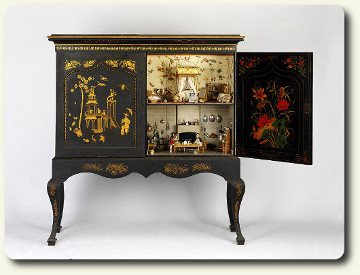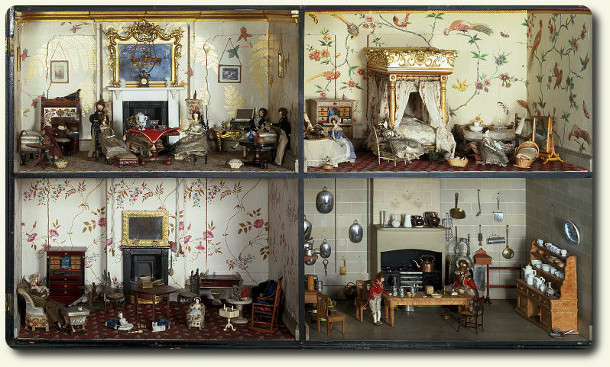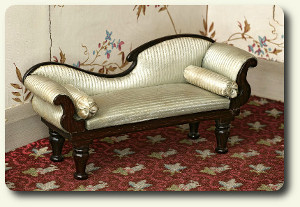


Another notable house must be mentioned, for several reasons. In 1835, a Manchester doctor noticed that the ladies in his house were making miniature items that would be appropriate for a dollhouse. Although by the end of the 18th century the popular cabinet house had been replaced with actual miniature
 buildings, the good doctor went against the trend and commissioned a copy of one of his favorite cabinets to be built so the ladies would have a place to showcase their work.
buildings, the good doctor went against the trend and commissioned a copy of one of his favorite cabinets to be built so the ladies would have a place to showcase their work.
It was not an ostentatious cabinet house, having only four rooms, and was furnished with both items made by his family and accessories purchased from London. The good doctor had combined tradition with modern culture. It wasn't a cabinet. It wasn't a house. It wasn't filled exclusively with expensive adult collections to be admired or used as a teaching tool. What then was it? It was fun!
The women enjoyed creating miniatures, bought others, and, gasp, played with it! How envied those women must have been. Oh, and by the way, the good doctor's name? John Egerton Killer. Yes, that is correct, Dr. Killer. Known as the Killer Cabinet House, one expects a gruesome scene of miniature torture, but instead is presented with a charming, trend-setting treasure, built and filled with love.
 The Nuremberg House, the Tate Baby House, the Denton Welch House, and the Killer Cabinet House are all on display at the Museum of Childhood, along with an impressive collection of other notable dollhouses.
The Nuremberg House, the Tate Baby House, the Denton Welch House, and the Killer Cabinet House are all on display at the Museum of Childhood, along with an impressive collection of other notable dollhouses.
Life went on as usual with the separation of social classes. But there was something brewing in Europe that would soon change the world forever. In the mid-1800's, Great Britain made a major change in their textile industry. Their development of iron-making techniques and increased use of refined coal impacted their economy in such a positive way as to catch the attention of the rest of Europe.
 What once took a man several hours, or even days, to make could now be made by a machine in minutes! New jobs were created, trade expanded, and the economy grew. The average person had more money to spend, and the wealthy class had to make room for the upstart 'nouveau riche'. With a better income and cheaper manufactured goods, the previously privileged treasure of a dollhouse was now within reach of the common man, or rather his daughter. Even his sons could now legitimately play with manufactured metal miniature soldiers instead of stealthily visiting the baby house, although one could wager that those soldiers stormed the dollhouse more than once, leaving a trail of broken chairs in their wake.
What once took a man several hours, or even days, to make could now be made by a machine in minutes! New jobs were created, trade expanded, and the economy grew. The average person had more money to spend, and the wealthy class had to make room for the upstart 'nouveau riche'. With a better income and cheaper manufactured goods, the previously privileged treasure of a dollhouse was now within reach of the common man, or rather his daughter. Even his sons could now legitimately play with manufactured metal miniature soldiers instead of stealthily visiting the baby house, although one could wager that those soldiers stormed the dollhouse more than once, leaving a trail of broken chairs in their wake.
The Industrial Revolution had brought miniatures to the masses.
Please join us next time for Part IV of The History of Miniatures: Nothing Can Stop Us Now!
For a delightful tour of the Petronella Oortman house, visit here. Be sure to click on the faint 'Next' at the bottom right of the page. Another extensive showing of dolls houses can be visited at the V&A Childrens Museum.
Part I: The History of Miniatures
Part II: The History of Miniatures "Miniatures Go Three Dimensional"
Custom Dolls, Houses & Miniatures / CDHM







